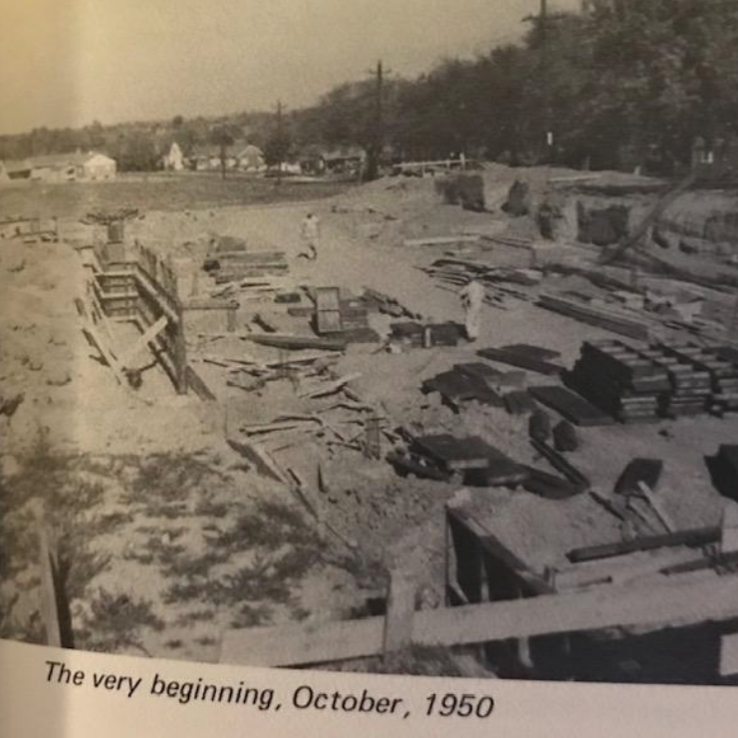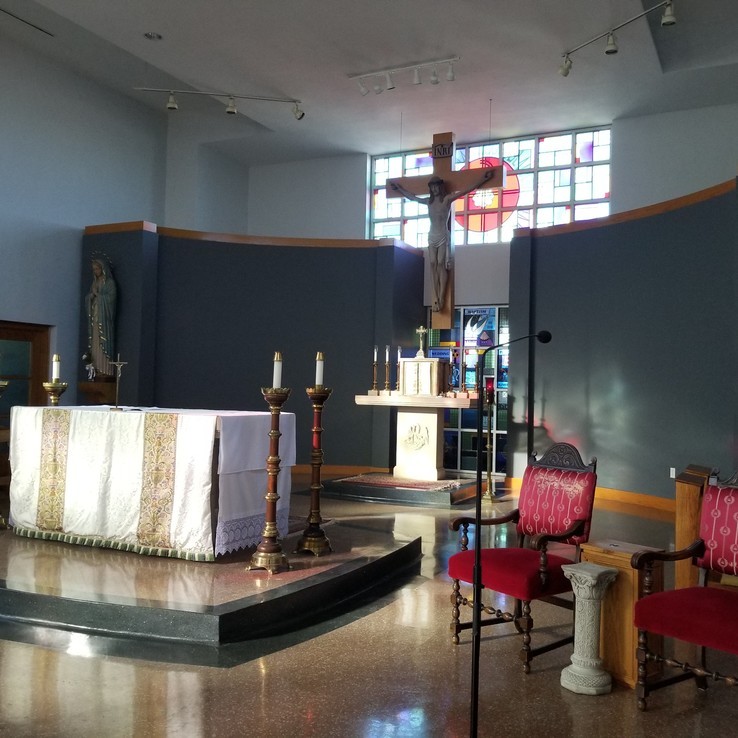
Archbishop John Glennon appointed Father Carl Rees as pastor. The Rev. Carl A. Rees, born September 29th, 1889, was the second son of Anton Rees and Wilhelmina (Wild) Rees at 2121 Arsenal Street, St. Louis, Mo. He was baptized at SS. Peter and Paul Church on October 1st, 1889. His elementary education was at St. Francis de Sales Parochial School, Gravois and Ohio, St. Louis. His First Holy Communion was May 3rd, 1903 and his Sacrament of Confirmation was September 18th, 1904. He graduated from SS. Peter and Paul High school in June of 1906. He attended St. Louis University, St. Francis Solanus College, Quincy and St. Francis de Sales Seminary, Milwaukee, Wisconsin. He was ordained a Priest by Archbishop Glennon at Kenrick Seminary, Webster Groves, June 13th, 1916 and celebrated his First Solemn High Mass at St. Francis de Sales Church, June 25th, 1916. Fr. Rees served as Assistant Priest at St. John the Baptist Church and at St. Augustine’s Church, both in St. Louis. First Pastorate was SS. Philip and James Parish, River Aux Vases, Mo. He was appointed to establish St. Martin of Tours Parish on January 12th of 1939.
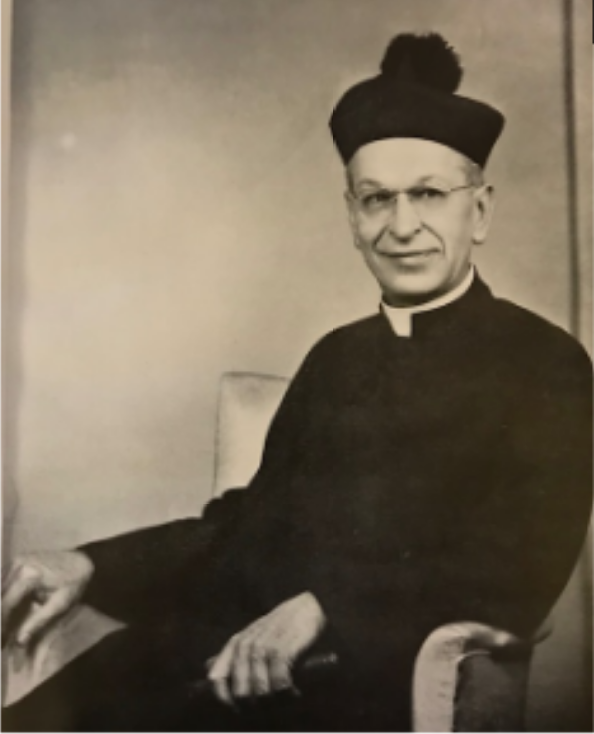
On Palm Sunday, April 2, 1939, it was announced that a new parish would be built and it would be named St. Martin of Tours. This announcement was made from the stage of the lower assembly hall of Notre Dame Convent where services were temporarily being held for a small congregation of “new” parishioners.
Prior to the Palm Sunday announcement, an office was established at 805 Cumberland Drive. Fr Huber, pastor of St. Andrew’s, furnished a list of families living “south of St. Andrew’s” and they were contacted by mail and invited to attend a general meeting at St. Andrew’s Hall on Thursday, February 16th, 1939. Those invited could respond by phone to “Riverside 5709” or by mail to the office. Included in the mail invitation was information about Holy Mass being said for the New Parish at the auditorium of the Notre Dame Convent on Sunday, February 19th at 8 A.M.
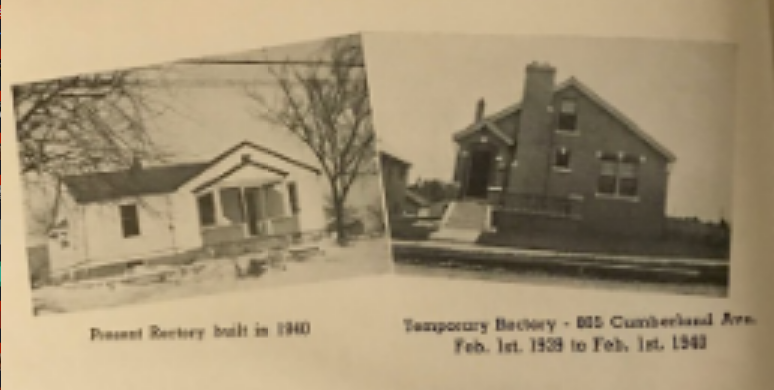
A Provisional Committee, “made up of sincere, level-headed men and women”, was formed to help work out plans for the building of the parish.
The Provisional Committee later became the General Parish Committee. For six months, until the middle of July, they met weekly. Funds were badly needed so various socials were held to raise money. A census was taken throughout the territory and subscriptions solicited but no one was found who would “sign” a pledge. It was the year 1939 and the big depression of the thirties stalked the memory of everyone. Memories of the depression rose each time Fr. Rees tried to obtain a building loan. Hoping to improve chances by raising collateral, the new pastor liquidated all his personal holdings but still met with no success. He inquired at every possible bank and was weary from trying. Fr. Rees turned to Bishop Winkelman who had assisted him with the parish’s start. With the Bishop’s signature, the loan was obtained. A troupe of volunteers from the Parish Committee made monthly collection visits throughout the territory. This system was discontinued with the distribution of Weekly Envelopes in November.
By the middle of March 1939, the site of the New Parish had definitely been determined – the south-west corner of Telegraph and Ripa Ave. This was a parcel of land measuring 2 ¼ acres and was purchased from the Forder Bros. Realty Co. There was some opposition to this site because it was thought that in a few years another parish would be needed a mile or possibly two miles to the south. Another possible site was what is now the Rose Gardens subdivision. The pastors of St. Andrew’s, St. Francis (Oakville), St. George (Gardenville), Seven Holy Founders (Affton), Assumption (Mattese), and the new St. Martin’s were called to a meeting with the Archbishop to discuss boundary lines of the new parish.
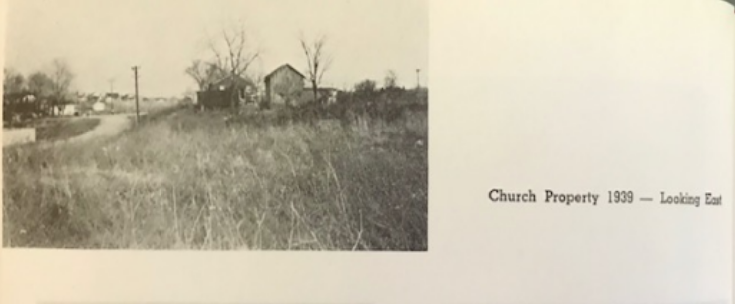
Boundaries were established as:
- Begin on Mt. Olive and Lemay Road
- Telegraph Road to West Loretta Street
- South side of West Loretta Street to Clyde
- West side of Clyde to West Arlee
- South side of West Arlee to Broadway
- West side of Broadway to Ripa
- South side of Ripa to the River
- Teddy Avenue to Barracks and along boundary of Barracks to the southern boundary of the Mehlville School District
- South on Lemay Ferry Rd (both sides of road) to southern boundary of the Mehlville School District
Thence, the Mehlville School District boundary on the west side and north side to starting point Mt. Olive and Lemay Ferry Road
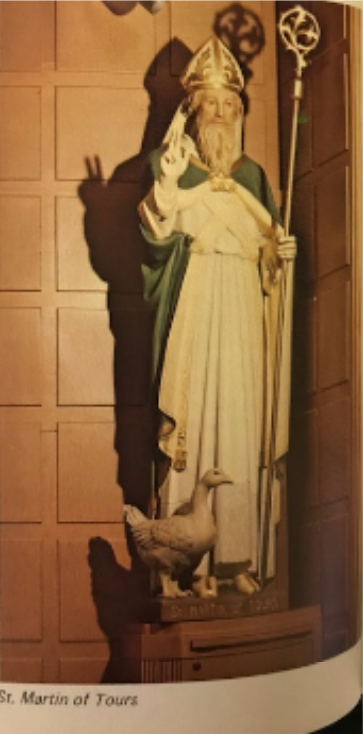 A new parish must have a name and a heavenly patron. A little strategy to procure this failed miserably. The donor of a substantial sum of money for the new parish would be given the privilege of naming the parish, subject of course to the Archbishop’s approval. Not the slightest nibble was received on this proposition. Suggestions were then requested and a formidable list resulted. Over 24 names were submitted. Three times the list was submitted to the Archbishop and each time the list was revised and became smaller. The list shrunk to 3 names: St. Martin of Tours, St. Raphael the Archangel, and St. Albert the Great. Presented with this list the Archbishop retorted in a flash: “St. Martin of Tours, now there is an excellent name for the new parish. I congratulate you, Father, upon your choice.” The “Letter of Appointment” and the “Decree of Erection” followed quickly.
A new parish must have a name and a heavenly patron. A little strategy to procure this failed miserably. The donor of a substantial sum of money for the new parish would be given the privilege of naming the parish, subject of course to the Archbishop’s approval. Not the slightest nibble was received on this proposition. Suggestions were then requested and a formidable list resulted. Over 24 names were submitted. Three times the list was submitted to the Archbishop and each time the list was revised and became smaller. The list shrunk to 3 names: St. Martin of Tours, St. Raphael the Archangel, and St. Albert the Great. Presented with this list the Archbishop retorted in a flash: “St. Martin of Tours, now there is an excellent name for the new parish. I congratulate you, Father, upon your choice.” The “Letter of Appointment” and the “Decree of Erection” followed quickly.
Excavation on the school building began on June 9th, 1939. Construction began on the 18th of the month. The bid by the Kloster Co., General Contractor, had been accepted. The Corner Stone, a gift of Mr. Ernest Speh of the Speh Monument Company, was placed with appropriate ceremony on Sunday, September 10th, 1939 by the Most Rev. C. H. Winkelmann. Committees assisted in locating and assembling all the countless furnishings needed for a church and school. Desks and other school equipment were located at and obtained from St. Francis de Sales Parish; pews, confessional, pedestals, etc., from Our Lady of Mt. Carmel; altar, vestment case and countless other things from St. Andrew’s Parish; Mass Vestments and altar linens, book stand, etc., from St. Liborious; Ciborium, etc., from Our Lady of Perpetual Help Parish; Gold Monstrance and Votive Stands from Msgr. Sisener of St. Agatha’s Parish; Stations of the Cross from Notre Dame Convent; Candlesticks, Vases, Vestments, etc. from SS. Peter and Paul’s Parish; and many other necessary things from many other places. Items were stored in various parishioners’ garages and basements.
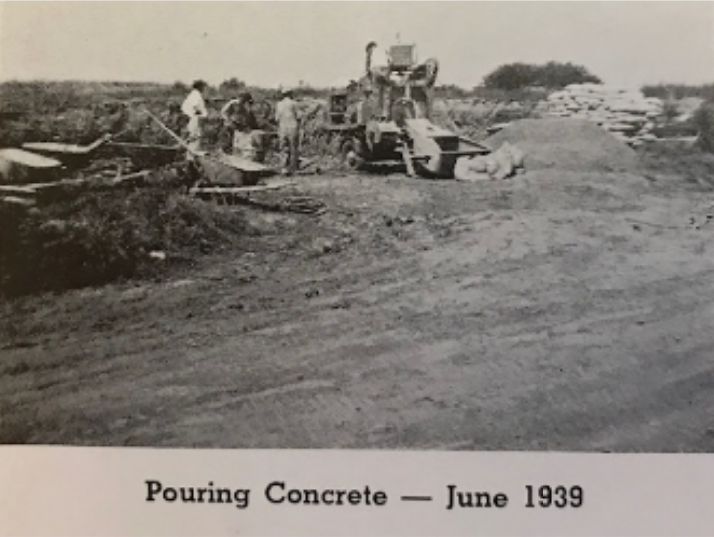
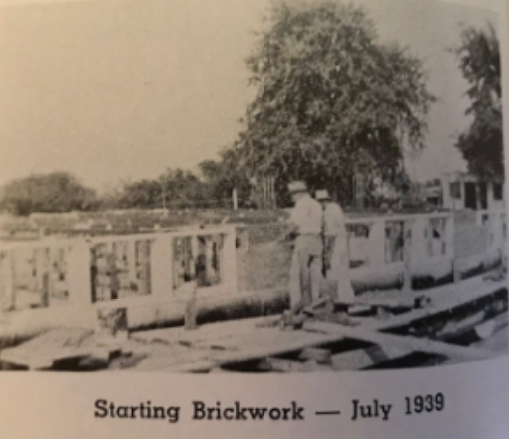
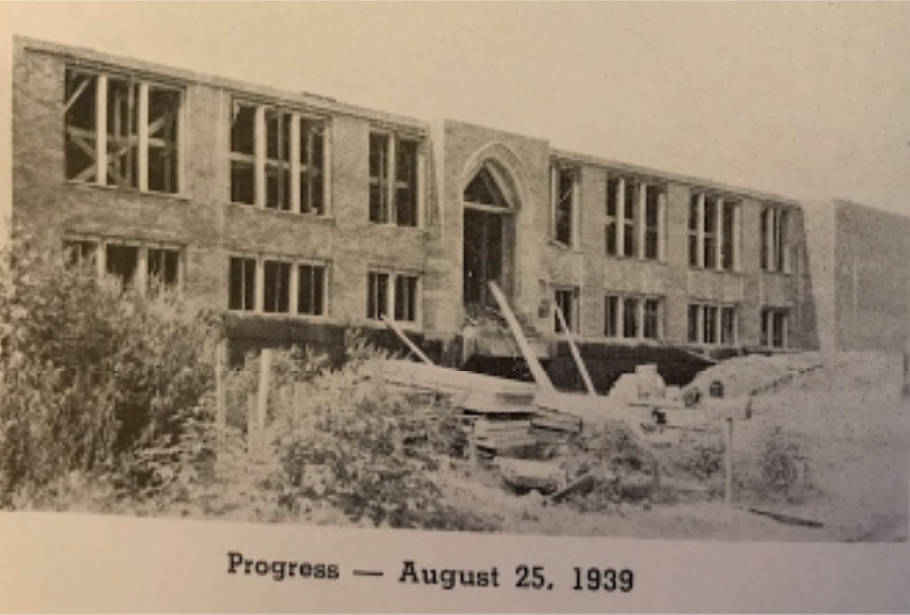
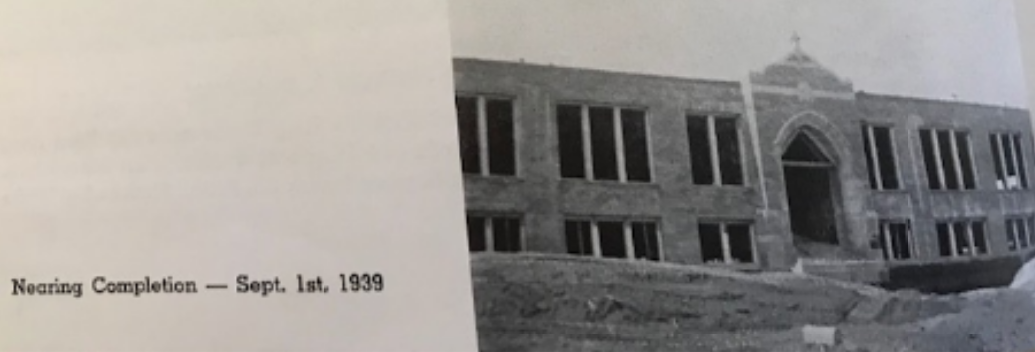
On Sunday August 27th, Marriage Banns were announced for the first time.
John Slucenschneider and Isabelle Vandeven’s wedding was performed on September 16th, 1939 at St. Andrew’s church.
The first Baptism recorded from the new St. Martin’s was that of Helen Emma Callison who was born on March 21st, 1939 and baptized on April 16th, 1939.
School opening day in September of 1939 found the school building not quite ready but by concentrating effort on the classrooms, school opened on the Feast of the Guardian Angels, October 2nd. Archbishop Glennon dedicated the school on May 26, 1940.

The chapel was ready in the new building (school) for the first service on Sunday, November 5th. Three Masses were scheduled and the Chaplain of Notre Dame Convent, Rev. Louis H. Bruns, would say the last Mass at 10:30. For over 6 years, or until the appointment of an assistant priest in February 1946, Fr. Bruns regularly served the parish with Sunday Mass and sermon.
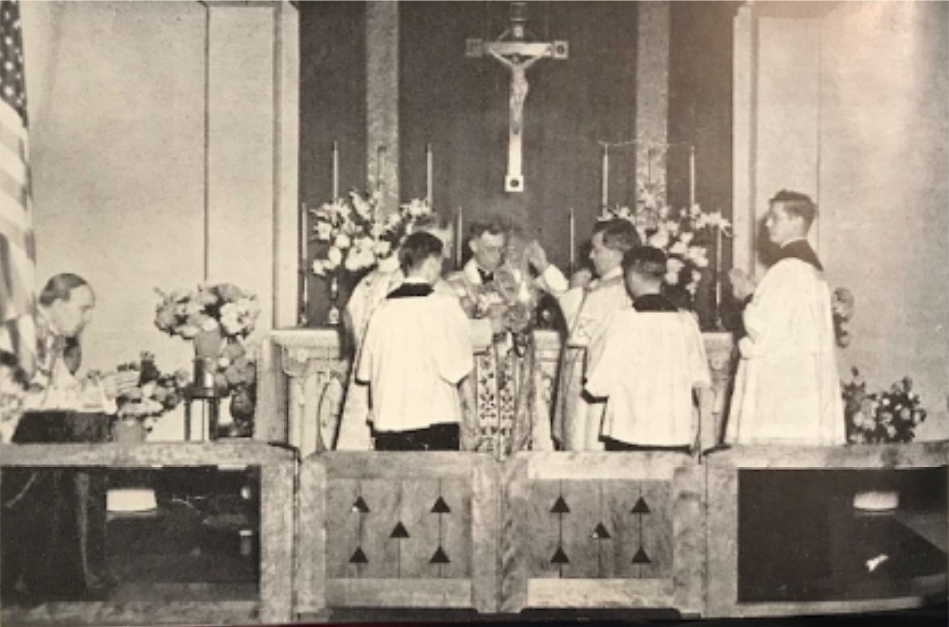
On January 22nd, 1940 the first funeral was held – Mrs. Naomi Chapman. The first Baptism in the new chapel was Myrna Claire Hahn and was held on November 5th, 1939. The first Christmas was memorable. A heavy snow had fallen and the premises glittered in a “white Christmas.” Mass was at 5 A.M. A loudspeaker had been erected on the roof of the building and played the famous record “Chimes from the Tower of the Monastery Church of the Archabbey of Beuron.” A little house crib was acquired and a small stable was made. The school children each received a Christmas box of sweets and in turn, brought the Christ Child a “birthday” present.
During the Lenten season of 1940, a Mission (from February 25th to March 10th) was conducted by the Redemptorist Fathers. The HOLY NAME SOCIETY and CONFRATERNITY OF CHRISTIAN MOTHERS were canonically erected during this occasion. 108 parishioners were enrolled as charter members of the HOLY NAME SOCIETY and Fr. Rees called the first meeting for April 15th, 1940. On January 7th, 1940 (before the Mission) a meeting was called with the purpose of organizing the ladies into a confraternity. 40 ladies attended this meeting. On March 3rd, 1940, on the closing day of the week of the ladies’ Mission, a solemn reception was held in the chapel and 100 ladies were enrolled as charter members. There was a second Mission held in March of 1945 and the third in the 10th Anniversary year in September of 1949.
Early in 1940, a little farmhouse was completed to serve as a priest’s house.
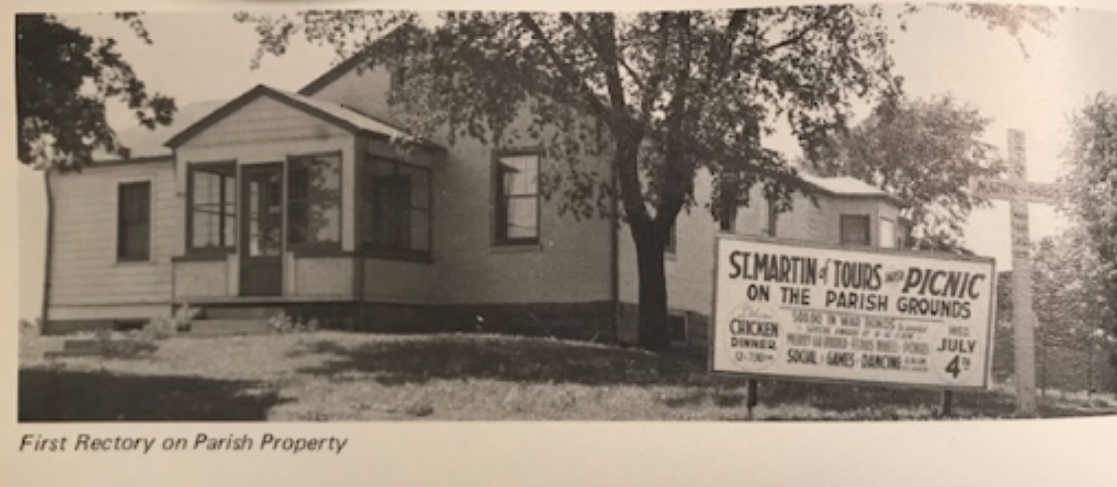
An outstanding event of the spring of 1940 was the First Holy Communion held on Sunday, April 21st.
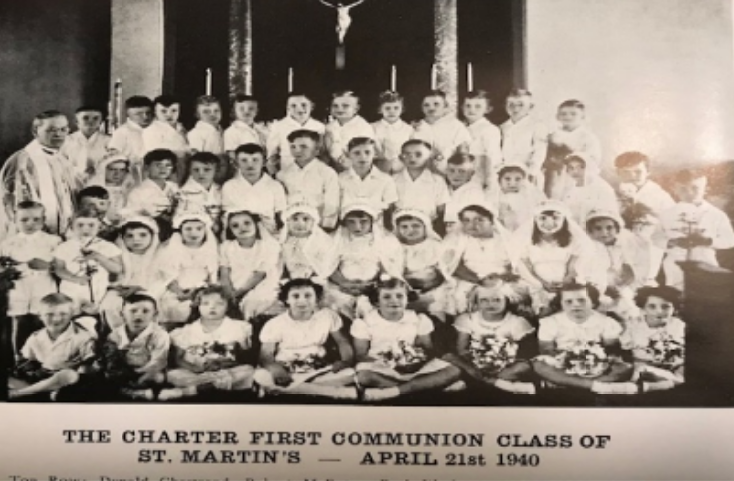
The war years were uncertain and trying. Many of our young men were called into service; food was rationed; wages were high and commodities scarce. Some 100 young men of the parish were drafted or volunteered for the army or navy. Three gave up their lives in the line of duty: Luke Deters, U.S. Navy died at sea; Eugene Muich, killed in action; Harry Vescovo died in camp. St. Martin’s conducted periodic drives for war funds.
Midst the din and rhythmic thud of hammers, nails, and woodwork, the first classes at St. Martin of Tours were held on October 2, 1939 with a total enrollment of one hundred sixty children. The classes were led by Sister M. Lambertine and the School Sisters of Notre Dame. In 1940 the enrollment started soaring – 190; 1941 – 204; 1942 – 205; 1943 – 211; 1944 – 222; and each year saw each classroom more crowded – four classrooms – four teachers! In 1945 another classroom was opened only to be filled to capacity – 5 rooms containing 269 children. This condition made all concerned realize the immediate need for even more rooms, hence plans were made and stakes were driven for our “Annex” which would supply two additional classrooms for use early in the fall semester. In 1946, the frame Annex was built to accommodate the ever-increasing enrollment. The Annex was opened for use on October 28th. By September 1948, enrollment was 329.
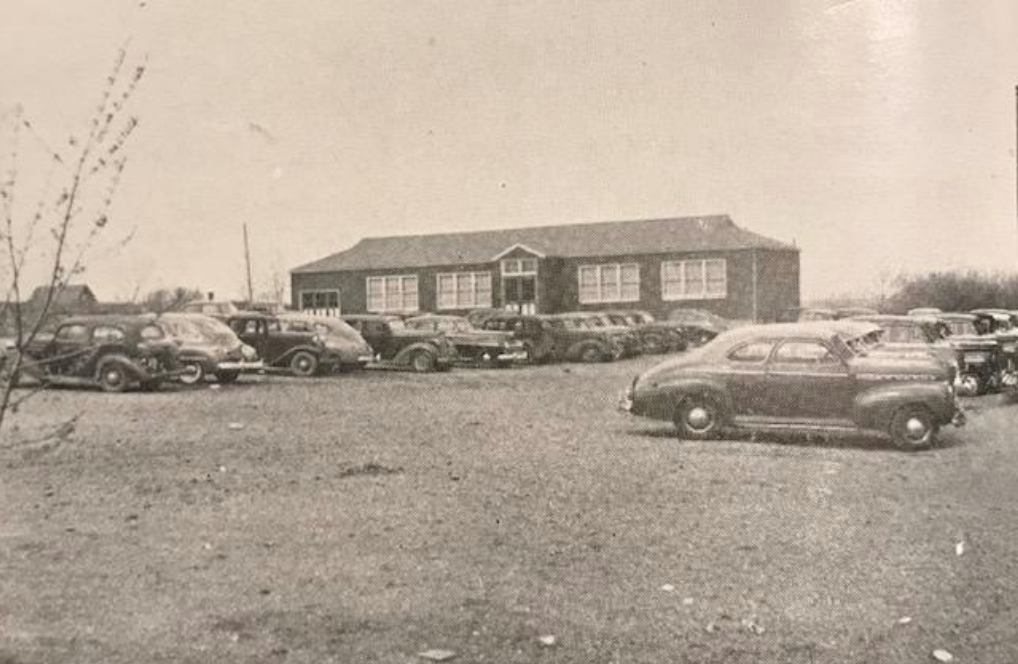
In April of 1941, dishes and a stove were bought and gas installed in the school kitchen. September 1941 was the beginning of our hot lunches for the school children. The kitchen was operated by two ladies of the W. P. A. (Works Projects Administration – an American New Deal agency). Fr. Rees stated that about 125 children were fed every school day. The first year of operation was completed successfully in June 1942 and a decision was quickly arrived at to continue the lunches in the following September. Due to rationing, the lunches started around October 12 at 10 cents a plate and served 145 children. By February 1943, the surplus foods furnished by the Government were discontinued but the school lunches continued. In September of 1943, Fr. Rees reported that the Government had diminished its allowance and that the Red and Blue Points necessary for purchasing foods were difficult to obtain. The lunch offerings were now 15 cents instead of 10 cents. The Council of Catholic Women had been furnishing the milk free of charge to the Catholic Schools. This service was discontinued. A charge of 5 cents was then made for the half-pint of milk served each child. From 1943 to 1946, about 140 children were served hot lunches every day. In September of 1945, Fr. Rees reported that due to help from the United States Agricultural Department lunches would be served with milk for 10 cents. The number of children participating in hot lunches increased
constantly. In September of 1946, 3 lady parishioners were placed in charge of the school lunches and menus. Some 200 children were fed every day. Due to the increase in the cost of food, lunches were now 15 cents.
By 1956, the population of the parish had increased enough to warrant adding a second story to the school building.
In June of 1956, Fr. Vincent Ott celebrated his First Solemn Mass at the parish, becoming the first former pupil of St. Martin’s to do so.
The St. Martin of Tours Band was established around 1967.
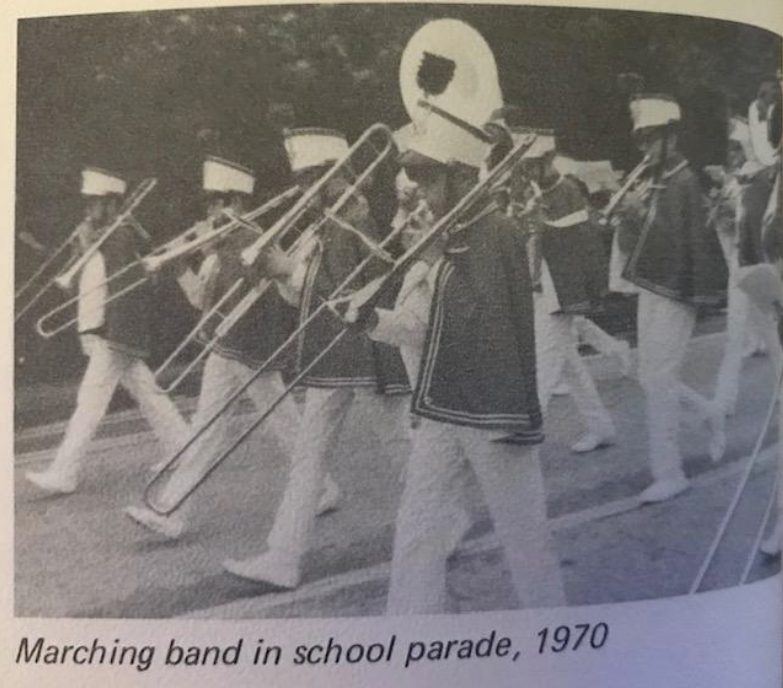
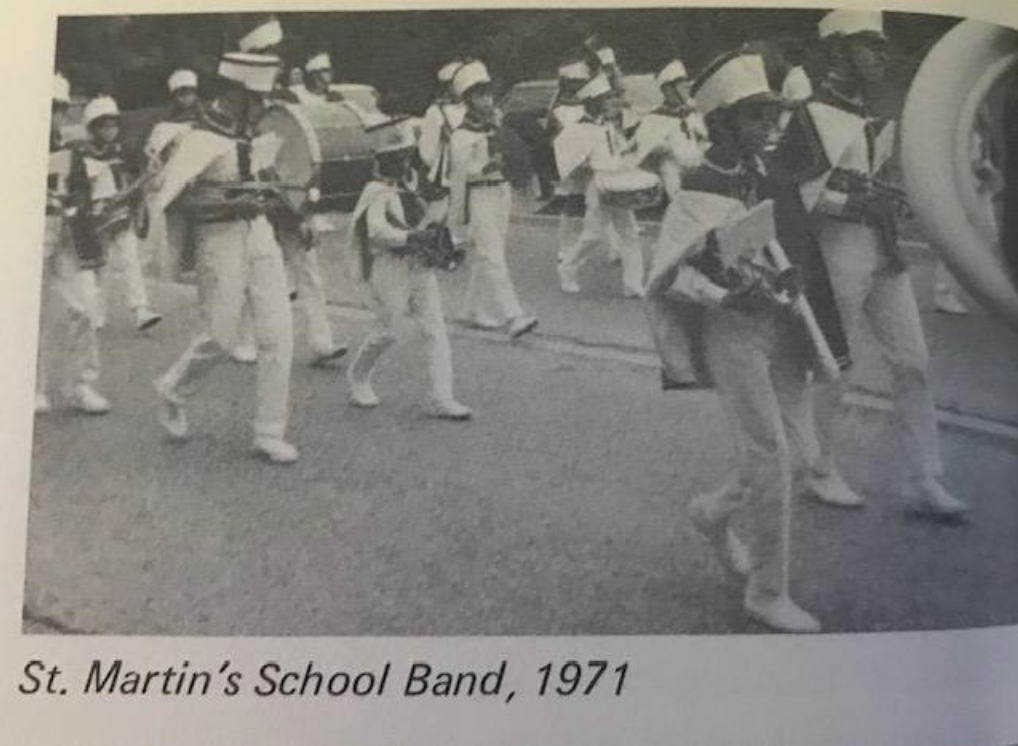
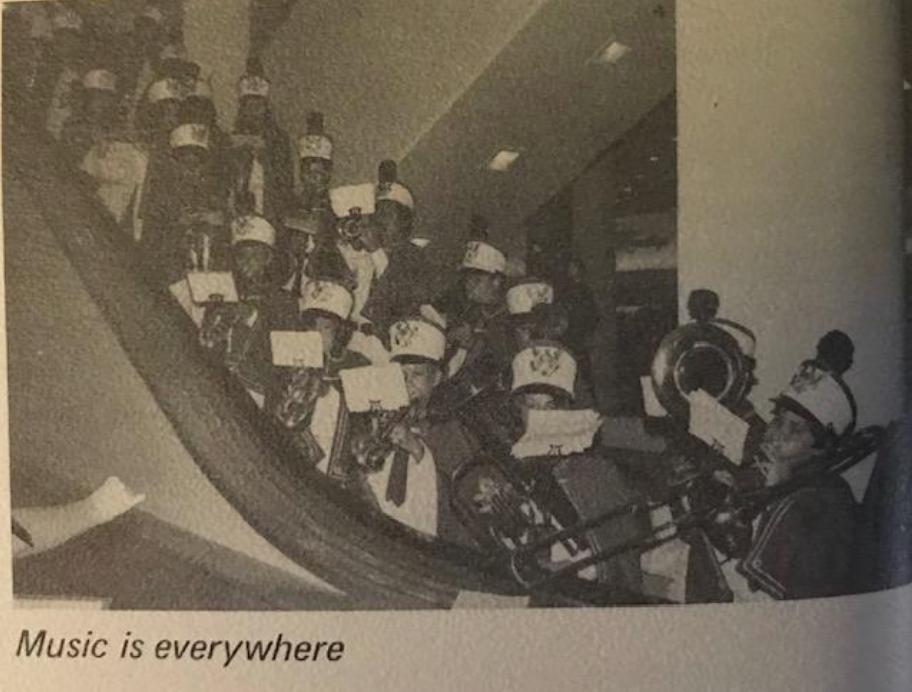
The School Sisters of Notre Dame staffed the school until the 1986-87 school year. The school closed in 2009
THE SEWING CIRCLE (LATER KNOWN AS THE QUILTERS): On February 21st, 1939, at a Provisional Parish Committee Meeting, it was decided that the parish ladies would meet weekly to sew at various homes of the members. Sewing was done at the ladies’ homes until the first quilting party which was held in the new building on Thursday, November 16th, 1939 with about 25 ladies present. With the cooperation of the neighboring parishes, the sewing circle was happy to offer 70 handmade quilts at their first annual quilt social which was held in the new building on April 27th, 1940.
TEEN SODALITY: In 1940, the first graduates left St. Martin of Tours and in the fall, the Teen Sodality was organized. The first enrollment took place on the Feast of the Immaculate Conception in 1940 at which time 10 graduates were enrolled.
USHER’S SOCIETY: In October of 1939 a permanent Usher’s Society was formed.
The SACRED HEART LEAGUE was established on August 23, 1940.
For the 10th anniversary year of the parish, it was decided to have a two-night Homecoming. This was held on Friday and Saturday, August 26th and 27th. The attraction was a Grand Fish Fry on Friday night and a delicious chicken dinner on Saturday night. There were also carnival concessions and rides and booths.
GIRL SCOUTS: In December of 1948, a representative of the Girl Scouts approached St. Martin of Tours about forming a troop. The first large affair was the Solemn Investiture in Church on Friday, April 16th, 1949. There were 65 girls and 22 adult scouts who recited the Girl Scout Laws and Promises and received a blessed Girl Scout Pin. In 1972, first-grade girls were invited into the program and given the name “Pixies.”
BOY SCOUTS: The Catholic Investiture Service and Charter Presentation of the first Scouts of St. Martin of Tours Troop 422 took place on January 21, 1952. It was funded by the Men’s Club. There were 10 adults and 30 scouts in the program.
WOMEN’S BOWLING LEAGUE: In June of 1947 the ladies formed a four-team bowling league. They elected to bowl at St. George’s Alleys on Thursday nights. The next year they bowled at the Holly Hills Lanes. Because of increased interest, an eight-team league was formed. In June of 1949, it was decided to bowl at the newly installed Bowling Alleys of St. Boniface Parish on Tuesday nights.
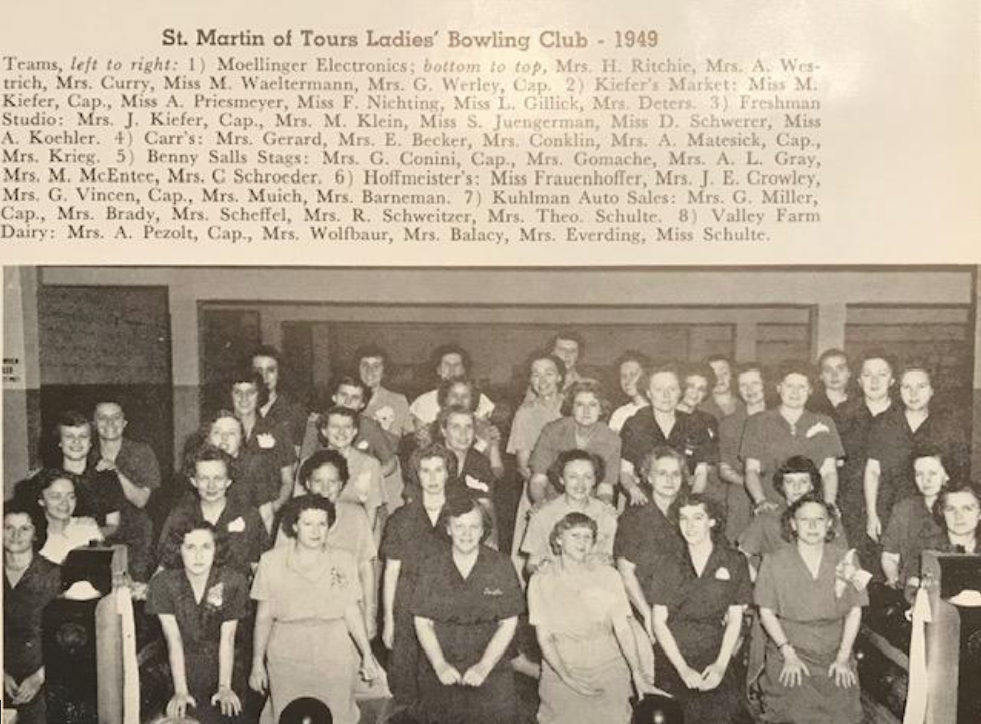
MEN’S BOWLING LEAGUE: The men’s league was first formed in 1947 with five teams and bowled at St. Andrew’s Church Bowling Alleys. In the 1948-49 season, they went to an eight-team league and needed to have a larger facility so they went to the Holly Hills Bowling Lanes. In the 1949-50 season, there were still 8 teams but the league was moved to the St. Boniface Bowling Alley.

In later years, bowling for both the men and the women moved to South Twin Lanes now known as DuBowl Lanes.
The first meeting of the BOARD OF TRUSTEES was held at the Rectory on December 18, 1946. The outstanding event in later years was the decision in 1947 to put on a drive for funds for a new church.
The Fund Raising Campaign sprang from a meeting of the Board of Trustees held on July 17, 1947. The purpose was to discuss the ways and means of raising a considerable amount of money to be set aside for the building of a new church. Many meetings concerning this topic were held. A campaign committee was appointed to assist in setting up the “Fair Share” contribution plan and the Kick-off Dinner. Sunday, November 9th was set as “solicitation day” and all members of the Campaign Committee were given a blessing by Fr. Rees. Before sundown that day, $60,000 had been pledged. November 1949 marked the end of the campaign.
Of note are the minutes from July 13, 1948. Additional property is necessary for the future adequate operation of the parish and now is the time to acquire it before the adjoining property is sold or developed. Fr. Rees and a member of the Board would contact and discuss the property matter with Mr. Forder, owner of the plot directly south of the church property. The contract to rent our building as a voting place was approved. Financially, the parish as of July 1st, 1948 has $14,601.43 in church treasury and $15,357.35 in New Church fund. Renovating the school kitchen and endeavoring to get floor covering was announced. The expense was to be met from the school lunch program.
The architect for the building would be Raymond Maritz with construction being awarded to the Charles C. Kloster Company. The new building (church) was to be situated on the sloping site adjacent to the school building with the entrance from St. Martin’s Lane. Provision was made for a future convent. The rectory would be situated between the church and the school. The nave of the church was designed to seat 750 worshippers and an assembly hall in the lower level would accommodate 1,000 people. With 3 meeting rooms and a kitchenette, the cost of the building was to be $400,000. Groundbreaking ceremonies were held on July 30, 1950. Approximately 1,000 people marched in the parade honoring the occasion and an estimated 500 others gave witness to the placing of the symbolic cornerstone of the new Church of St. Martin of Tours in Lemay. On April 22nd, 1951, the Most Revered Joseph E. Ritter, Archbishop of St. Louis, performed the cornerstone-laying ceremony. Dedication of the Church was held on August 3, 1952.
During these years, the rectory was moved from the small farmhouse on Telegraph Road to Tweed Drive to its present location adjoining the church.
The Men’s Choir was begun in the 1950s. During one Christmas season, they performed on KMOX radio.
In 1958, a committee was formed within Confraternity of Christian Mothers and it was called the Home and School program. The 12 members received special training to enable them to assist with health-testing for the children. The volunteers kept health records, did library duty, office work, and took charge of the uniform sales and exchanges.
ATHLETIC ASSOCIATION: Starting originally with 3 girl’s softball teams (year unknown), the program increased in numbers and activities that now include in 1974 (?) 273 children playing on 11 softball teams, 10 baseball teams, 13 soccer teams, 3 volleyball teams, and 4 basketball teams.
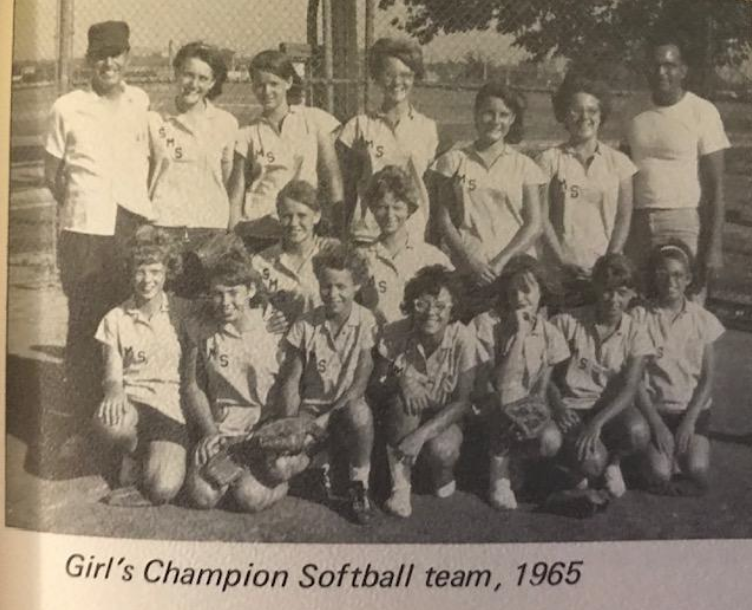
The “Harry Noss Invitational Tournament,” named for a deceased young man from the association, is a special event of the year in which second-grade boys baseball teams compete. In 1964, the program was expanded to include public school children.
On Christmas night of 1959, exactly 20 years after he had celebrated the first Christmas Mass in the parish he loved so well, Fr. Carl Rees passed away following a stroke.
In January of 1960 the Right Reverend Monsignor Anthony A. Esswein arrived to replace Father Rees.

Under Monsignor Esswein’s direction, the Men’s Club, the St. Vincent de Paul Society (1960) and the Senior Adult Club (1962) were formed. The Sisters’ Convent was built and all parish indebtedness to the Archdiocese was paid. The original sanctuary was completely remodeled.
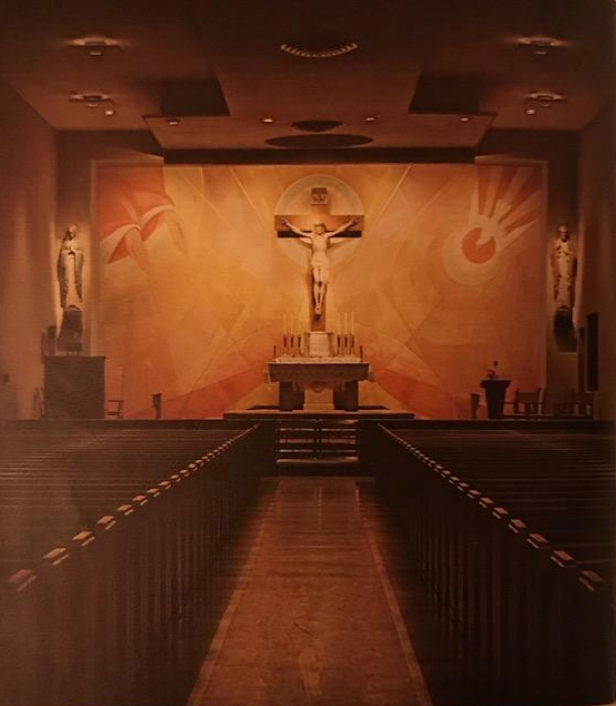
Monsignor Esswein suffered a stroke and died in October, 1972.
Many organizations/clubs have been added to the St. Martin of Tours community since its early days. Some have just changed names.
They include: Finance Board, Parish Council, Stewardship Committee, Liturgical Ministries (Servers, Lectors, Extraordinary Ministers of Holy Communion, Adult Choir and Cantors, Gift Bearers, Liturgy Commission, Altar Society and Ushers & Greeters), Blood Drive, Adult Education, Pro-Life, Scrip, Money Counters, Funeral Choir, Art & Environment, Legion of Mary, Funeral Luncheon, Bingo Committee, ACA, and Rectory Volunteers.
Current church interior after 2020 renovation (click to enlarge):


